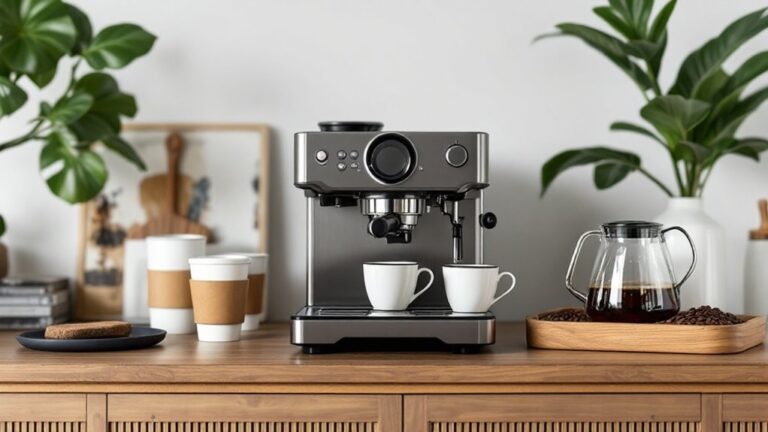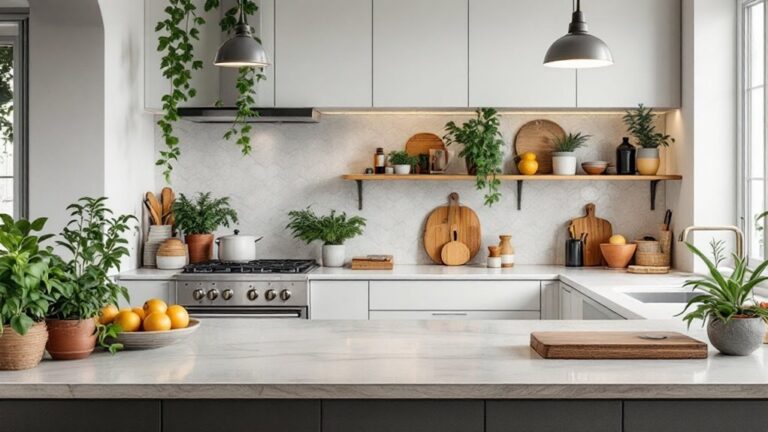Maximizing storage in small kitchens involves a meticulous approach to utilizing vertical space, optimizing cabinetry, and enhancing drawer organization. Employing wall-mounted shelves and ceiling racks exploits unused vertical sections, while under-cabinet solutions and hooks increase functionality. Customizable shelving within cabinets, along with clear containers and pull-out systems, enhances accessibility and organization. Innovative designs such as full-height cabinetry and open shelving integrate aesthetically with practical needs. Multi-functional solutions like movable islands and fold-down tables provide additional workspace and flexibility. For a thorough understanding of how to transform limited kitchen space into an efficient and visually appealing area, further exploration is encouraged.
Designing Keys
- Use wall-mounted shelves and hooks to utilize vertical space efficiently.
- Install pull-out shelves and door-mounted organizers for easy cabinet access.
- Employ magnetic strips for storing metal utensils and knives.
- Add stacking bins and under-cabinet shelves for additional storage in overlooked areas.
- Opt for movable kitchen islands to increase storage and workspace flexibility.
Utilizing Vertical Space

In small kitchens, effectively utilizing vertical space can greatly improve storage capabilities, transforming even the most compact areas into functional and efficient environments. Wall mounted shelves serve as versatile solutions, offering both storage and decorative possibilities while maximizing underutilized wall space. These shelves can hold a variety of items, from jars and canisters to decorative dishware, providing easy access and a visually appealing display. Additionally, ceiling racks offer an innovative approach to utilizing vertical space without encroaching upon valuable wall areas. Such racks are ideal for hanging pots and pans, thereby freeing up lower cabinets and creating a culinary studio aesthetic. Beyond conventional shelving, wall-mounted rails provide practical options for hanging essential kitchen tools like utensils, pots, and pans, achieving both organization and ease of access. Incorporating wall-mounted plate display racks offers shallow storage solutions, ensuring that even narrow spaces are utilized effectively. Vertical dividers are also useful in organizing items such as baking sheets and cutting boards, which can be easily stored upright to maximize space efficiency. For households with limited floor space, hanging larger items like mops and ironing boards on walls can greatly declutter the environment.
Optimizing Cabinet Storage
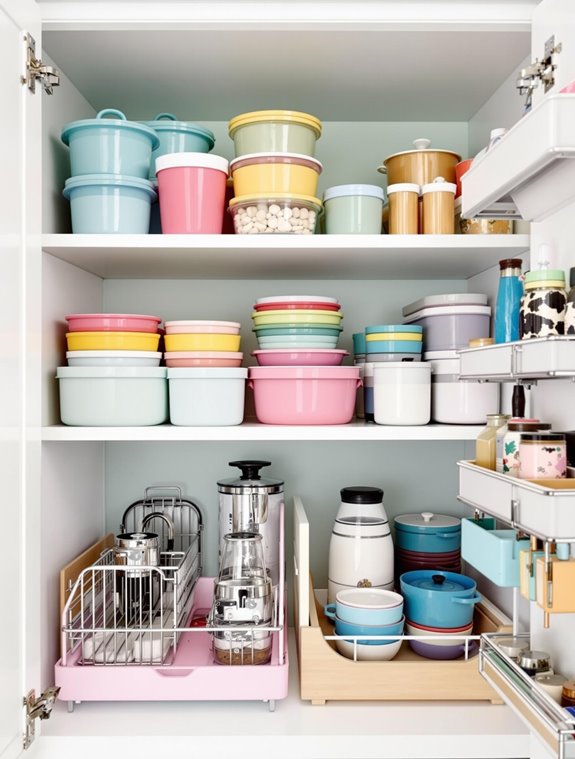
Efficient cabinet storage can be a game-changer for small kitchens, where every inch counts. Optimizing the layout through strategic shelf arrangement is vital to accommodate a variety of kitchen items. Implementing customizable shelves allows for the adjustment of storage spaces to fit items of diverse sizes and shapes, thereby maximizing utility. Vertical storage solutions can further enhance organization by utilizing wall space with upper cabinets extending to the ceiling to eliminate dust-collecting gaps.
Grouping similar items in designated zones enhances organization and accessibility, while clear storage containers or labels help in identifying contents swiftly, mitigating the need for unnecessary rummaging.
Accessibility is another key aspect; frequently used items should be placed at eye level for ease of reach, whereas those used less often can be stored in less accessible areas. Decluttering is essential—removing duplicates, unused gadgets, and expired food can liberate valuable space, enhancing the overall efficiency of the cabinet storage.
Incorporating various cabinet accessories can further optimize storage. Pull-out shelves and door-mounted organizers provide easy access to items at the back of cabinets, while Lazy Susans facilitate the use of corner spaces.
Utilizing stackable bins and pull-out baskets for organizing smaller items and dry goods guarantees that every available space is used effectively, transforming even the smallest kitchen into a well-organized and functional area.
Enhancing Drawer Organization

While cabinets are instrumental in maximizing storage, drawers play an equally essential role in maintaining an organized kitchen. The incorporation of adjustable drawer dividers serves as a pivotal design element, allowing the customization of space within drawers to accommodate various kitchen essentials.
These dividers, available in sizes that expand to fit the drawer's dimensions, guarantee that no space is left unused. By creating individual compartments within the drawer, items such as rolling pins and hot pads are allocated specific areas, thereby enhancing organization and accessibility. Some dividers even include inserts for customized compartment sizes, further optimizing the use of available space.
In addition to dividers, clear compartments offer a strategic advantage in drawer organization. These organizers, with transparent sections, considerably improve visibility, enabling quick identification and retrieval of items without the need for extensive searching.
The integration of shelf inserts further augments storage solutions by introducing additional layers within drawers, thereby optimizing storage capacity. For specific items like knives, specialized storage blocks with cork dividers guarantee safety and orderliness.
Expandable organizers, featuring waterproof coatings, provide versatile storage options for utensils and tools, maintaining an organized environment. By strategically placing frequently used items in accessible locations, these solutions streamline kitchen workflow, guaranteeing efficient storage and accessibility.
Leveraging Behind-the-Door Storage
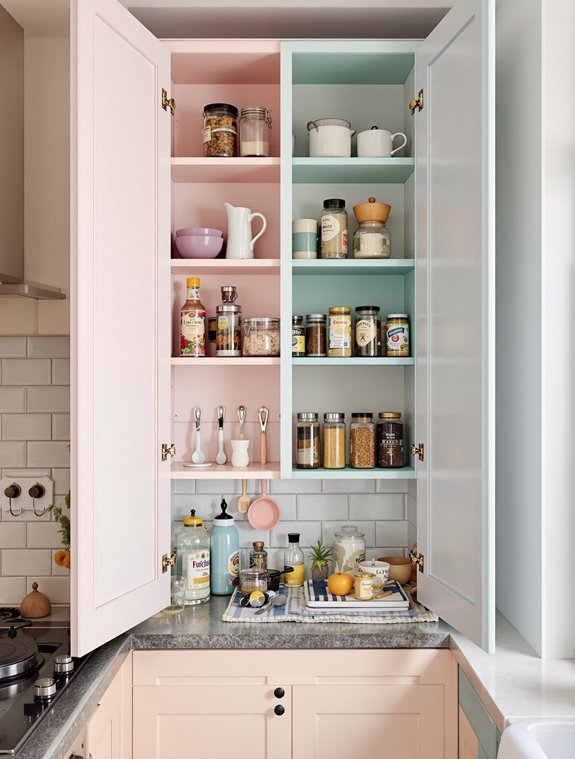
Maximizing storage in small kitchens often requires innovative solutions, and leveraging behind-the-door storage offers an efficient approach to declutter and organize space. The strategic use of door organizers, such as wire baskets and shelves, can greatly enhance storage capacity without encroaching on valuable floor space.
By utilizing the back of cabinet doors, homeowners can store small yet essential items like spices, measuring cups, and spoons, thereby freeing up shelf and drawer space for larger appliances and utensils.
Incorporating cabinet hooks and racks on door backs accommodates items like cutting boards and jars, ensuring they remain accessible yet out of the way. Ready-made solutions, such as the Rev-A-Shelf chopping board holder, provide sturdy, convenient options for maximizing vertical space. Swing-out corner cupboard storage solutions also improve accessibility by transforming awkward spaces into practical storage areas, allowing for easy viewing and retrieval of items through adjustable trays.
It is essential to adapt these storage solutions to individual needs, utilizing various hooks, boxes, and storage boards to keep items orderly.
Moreover, integrating narrow shelves behind kitchen doors can store jars and cleaning materials, while over-the-door hooks offer tool-free installation options. Ensuring that cabinet hinges can support the additional weight is critical to maintain structural integrity.
Thoughtful customization, including labeling, facilitates easy access and identification, streamlining kitchen organization efforts.
Creating Efficient Work Zones
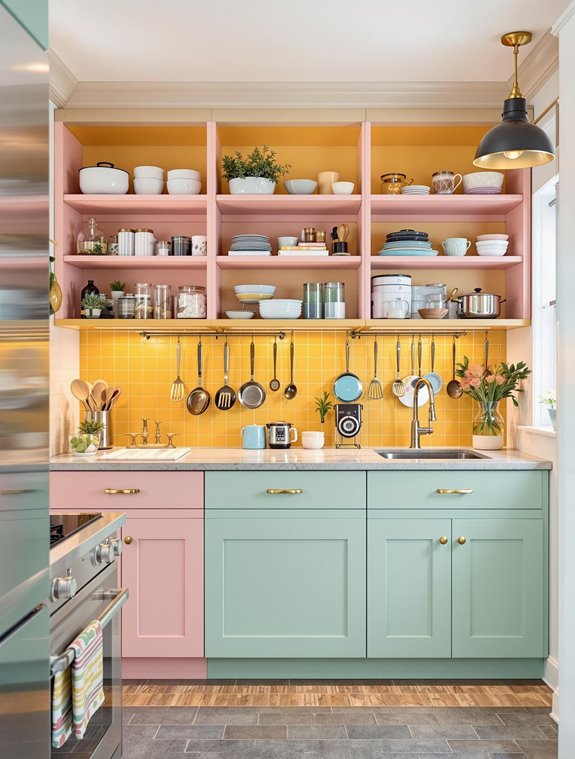
A well-organized kitchen is the result of thoughtfully defined work zones that enhance efficiency and functionality. The strategic zone layout guarantees that each area, from storage to preparation, cooking, cleaning, and serving, is optimized for task efficiency.
The storage zone, for example, categorizes items by frequency of use, guaranteeing that essentials are within easy reach. In the preparation zone, ample countertop space is vital, providing access to dry and liquid ingredients, mixing bowls, and appliances necessary for meal preparation.
The cooking zone focuses on the stove, incorporating landing spaces for temporary item placement and task lighting to improve visibility for intricate cooking tasks. Adjacent to this, the cleaning zone is designed for a seamless flow of dirty dishes, with the dishwasher conveniently located next to the sink.
The plating or serve zone facilitates a smooth shift from cooking to serving, with dinnerware and glassware readily accessible. Ergonomically, maintaining 4 feet of clearance between opposing countertops ensures comfortable movement, with counter heights adjusted to suit various tasks. Efficient layouts, such as triangular equipment positioning, are known to enhance the overall cooking performance by reducing unnecessary movement.
Proper lighting and ventilation systems, tailored to specific zones, further enhance the kitchen's functionality, creating an environment that supports efficient workflows.
Using Creative Storage Solutions

After establishing efficient work zones, enhancing the utility of a small kitchen involves embracing innovative storage solutions.
Utilizing vertical space effectively through innovative shelving can transform a cramped kitchen into a highly organized space. Wall shelves, incorporating rails and shallow designs, allow for the hanging of pots, pans, and utensils, while simultaneously providing storage for jars, containers, and spices. Magnetic strips, strategically mounted on walls or refrigerator sides, offer an alternative to traditional drawer storage, freeing up valuable space. One innovative approach is using full-height cabinetry to extend storage to the ceiling, reducing countertop clutter and maximizing available space.
Open shelving introduces a dynamic display option for dishes and small appliances, contributing both functionality and aesthetic appeal. The clever containerization approach, using under-cabinet shelves, maximizes dead space, creating additional layers for storage without cluttering the work area. Hooks, whether inside cupboard doors or on plain walls, offer practical hanging solutions for various kitchen items.
Incorporating multi-functional items, such as movable kitchen islands and fold-down tables, further enhances space efficiency. These elements add both storage and flexible workspace.
For hidden spaces, under-sink storage with stacking bins and behind-the-door baskets provide solutions for often overlooked areas, ensuring every inch of available space is utilized, thereby maximizing overall kitchen functionality.
Frequently Asked Questions
How Can I Maintain an Organized Kitchen With Limited Countertop Space?
To maintain an organized kitchen with limited countertop space, utilize vertical storage solutions by installing magnetic strips for knives and utensils. Incorporate wall-mounted shelves to keep countertops clear, maximizing efficiency without sacrificing accessibility or style.
What Are Some Tips for Reducing Clutter in a Small Kitchen?
To reduce clutter in a small kitchen, employ drawer organizers and vertical storage solutions. Categorize and declutter regularly by discarding unnecessary items, consolidating duplicates, and ensuring each item has a designated space to maintain organization.
How Can I Make My Kitchen Feel More Spacious Without Renovations?
Illuminate your kitchen with a symphony of light; strategic lighting effects can visually expand the space. Pairing these with light kitchen colors creates a more airy atmosphere, fostering a sense of spaciousness without the need for renovations.
Are There Eco-Friendly Storage Solutions for Small Kitchens?
For small kitchens, eco-friendly storage solutions include using sustainable materials such as bamboo and recycled glass. Implement vertical storage options like magnetic spice racks and floating shelves to enhance organization while maintaining an environmentally conscious approach.
How Do I Prioritize Which Kitchen Items to Keep or Store Elsewhere?
"Less is more" aptly applies. Prioritize keeping essential kitchen tools within arm's reach, while storing seasonal items in less accessible spaces. Regularly assess usage frequency to guarantee efficient organization and maintain a clutter-free kitchen environment.
Wrapping up
To summarize, the strategic utilization of vertical space, optimized cabinet storage, and enhanced drawer organization are pivotal in maximizing functionality within compact kitchen environments. By leveraging behind-the-door storage and establishing efficient work zones, one can achieve significant spatial efficiency. Creative storage solutions further augment the kitchen's capacity, ensuring that each element is meticulously organized. This approach underscores the theory that intelligent design and architectural innovation can transform limited spaces into highly functional and aesthetically pleasing culinary environments.



